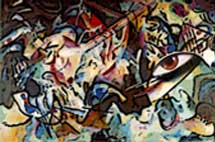
[class
information][html][theory][photoshop][dreamweaver]
[home] [fims]
[uwo]
In photoshop: [tour][mr. melonhead ][tips & tricks][color theory]

.gif)
Tips for Assignment 2 A .....>>
Tips for Assignment 2 B & C.....>>Bonus Tip:
Keyboard shortcuts...>
A complete list of keyboard shortcuts from EyeWire.
from the original Photoshop Tour, I've posted the short form
notes that I've adapted here, with some comments on the
various topics.
Quick Tour
Selecting
Layers
Add type
Layer Effects
Filters
Painting
You will need three files to go through the tour that comes with Photoshop 5.5. They are: Tour.psd, CD.psd, and Horn.psd, and you'll find them under Photoshop/Training/Photoshop5/Tour/
Selecting is one of those basic concepts that you have to learn when you start using Photoshop. Essentially, selecting is the process of collecting a part (or all) of an image so that you can manipulate it. There are almost as many ways of selecting parts of an image as there are ways of manipulating it. You can use the marquee tool, the magic wand tool, the lasoo tool, and the pen tool (creating clipping paths that you can load as a selection). Here we will only use the marquee tool and the magic wand:
- Open CD.psd, Horn.psd and Tour.psd Click on the title bar of CD.psd to make active.
- Change marquee tool from box to elliptical. Highlight the CD (hold down shift).
- Select the move tool and put the CD on top of the sheet music (Tour.psd)
- Change size of the CD now. Choose edit > Free transform
- Reduce the size and spin about 30 degrees counter clockwise.
- Select Horn.psd. Select the magic wand tool and highlight all of the white text. (You will need to hold down shift.) Once you've selected the white, go to Select > inverse.
- Then select the move tool and move the horn to the tour.psd file. (This creates a copy the horn.)
- Chose File > save as: Save the new file as tournew.psd, so other classes can use the original tour.psd file.
- Close the other files.
Before the invention of digital images, designers had to use layers of acetate (clear plastic) to create the effects that we can do so easily now in Photoshop. The layers palette lets had you organize artwork on separate transparent layers so that you can play with a composite images. Note, if you are trying to manipulate your file, and you can't seem to do it, one of three things has probably happened: 1) you're working in the wrong layer, 2) you have a section of the image selected, 3) your computer has crashed.
You should still have the tournew.psd file open:
- Click the Layers palette tab to bring the layers palette up (Windows> Show Layers). You'll see that each files has several thumbnails, showing you your layers.
- Use the Layers palette to put the horn between the CD and the background.
- Change the opacity of the CD to 40%.
- Click on multiply in the "blending modes" pulldown (at the top left of the Layers Palette).
[class
information][html][theory][photoshop][dreamweaver]
[home] [fims]
[uwo]
page created by Mark A. Rayner, ©2003